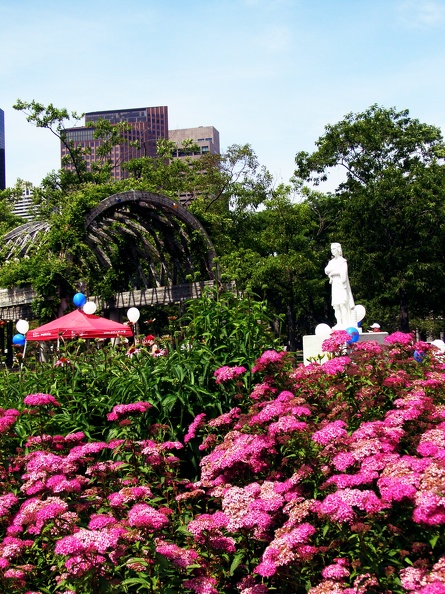On Sunday, the day before Columbus Day, about 300 evil excuses for human beings held what they described as a “Day of Rage” in Portland, Oregon to protest against the Italian explorer. Disgustingly, they tore down statues of Abraham Lincoln and Theodore Roosevelt, fired bullets through the window of a restaurant, and smashed the windows of numerous buildings, including restaurants, a jewelry store, a bank, and a coffee shop. They also attempted to burn down the Oregon Historical Society, breaking windows and throwing flares inside, and stole and damaged a historic quilt made by 15 African-American women to celebrate America’s bicentennial.
According to CNN, flyers for the Day of Rage warned that photography and videography would not be allowed. Apparently whoever organized this event is unaware that in America, there is this thing called the First Amendment. In addition to providing evidence that the protesters intended to commit criminal actions, it is obnoxious that someone would believe they have the right to tell other people that they are not allowed to take photos or videos in public places.
At least two people have been arrested to far, according to local news station KGW. Brandon Bartells, 38, of Pasco, Washington was charged with first-degree criminal mischief and riot for tearing down the Roosevelt statue. He allegedly chained his van to the statue and used the vehicle to pull it down. Malik Fard Muhamad, 23, of Indiana was charged with first-degree criminal mischief, riot, and unlawful possession of a firearm. He allegedly smashed the windows of the Historical Society and other buildings with a metal baton.
According to journalist Andy Ngo, one of the rioters, Amanda Siebe, is running for Congress. “It was so f***ing wet tonight,” she tweeted. “But still, we brought down 2 statues. It was an amazing thing to see those statues fall!” The prospect that someone who thinks like this and writes publicly in such an unprofessional manner might hold public office is disturbing.
Ngo also reported that the restaurant that was shot at, Heroes American Cafe, was targeted because it was decorated with photos of first responders.
The City of Portland said that the damage to the statues will cost $30,000 to repair. This is after rioters already destroyed statues of George Washington, Thomas Jefferson, and an elk in the same city.
District Attorney Mike Schmidt called this weekend’s vandalism “sickening,” “inexcusable,” and “without purpose and justification.”
I could not agree more. I condemn these destructive actions in the strongest of terms. Contrary to the sentiments expressed by congressional candidate Amanda Siebe, the destruction of statues is the exact opposite of “amazing.” It is repugnant and despicable. The fact that someone would deliberately pull down a beautiful, magnificent piece of art, and then be happy about this accomplishment, is completely incomprehensible. Every time a monument is torn down, my soul feels like it has been stabbed. Every loss of a statue makes the world a worse place. How could someone do such a thing or express joy about it?
It is also completely illogical that supporters of Antifa and Black Lives Matter would have such a thing as a “Day of Rage.” Those who support these movements have absolutely nothing to be angry about. They have gotten their way on everything. All four major sports leagues and countless celebrities vigorously support their movement. Any person or institution that dares to express dissenting views is immediately condemned, boycotted, and/or fired. Members of these movements have already destroyed hundreds upon hundreds of businesses, buildings, and priceless statues, as well as assaulting and killing innocent people. They have succeeded in causing the Confederate States of America and its iconography to be almost completely obliterated from our society, Christopher Columbus to be slandered as a mass murderer and his holiday replaced with Indigenous Peoples Day in many states, and even founding fathers such as George Washington and Thomas Jefferson to become controversial.
It is those on the opposite side – those who admire the Confederacy and/or Columbus and/or the founding fathers – who have the right to be enraged. Our statues have been brutally destroyed and our culture and history mercilessly attacked. And now, bizarrely, those who have been trampling on our rights have the audacity to claim to be “enraged” by us, the people on whom they have been trampling. The “Day of Rage” participants and all those who share their beliefs are bullies with no tolerance for any cultures, opinions, or values other than their own. Christopher Columbus is a hero and a cultural symbol to many Italian-Americans, including myself. To hold an event whose sole purpose is to demonstrate rage towards a holiday that celebrates Italian heritage is an act of bigotry. Everyone who participated in this event deserves to be charged with a hate crime.



